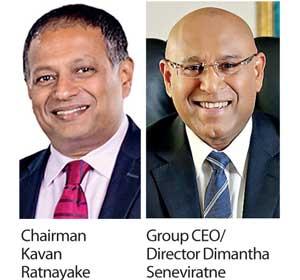14 Nov 2019 - {{hitsCtrl.values.hits}}
National Development Bank PLC (NDB) stood tall among its peers during the three months ended September 30, 2019 (3Q19) as the lender enjoyed more room for its loan book expansion with regulatory changes that ended up in its favour.
NDB turned cautious in expanding its loan book during the first half of the year due to possible capital adequacy constraints with its asset base growing over Rs.500 million.

However, NDB finally ended up giving Rs.36.4 billion in new loans during the nine months to September, half of which came during the quarter
under review.
This translates into a 10.3 percent growth, which is well above the growth reported by any other lender in the market marred by negative sentiments.
NDB appeared to have been staying with pent-up ability for growth until the Central Bank told the lender that it did not qualify to become a Domestic-Systematically Important Bank (D-SIBs) although it crossed the Rs.500 billion in assets as the regulator is in the process of finalising a new assessment methodology for D-SIBs.
NDB crossed the milestone and ended the quarter with an asset base of Rs.505.4 billion.
According to the previous methodology, a bank with assets of Rs.500 billion is deemed to be a D-SIB with its minimum mandated capital adequacy ratios automatically increasing to 10 percent and 14 percent, respectively.
Had the previous direction been in effect, NDB would have already breached its Tier I capital adequacy ratio, which is currently at 9.52 percent. With its Tier II ratio also at 14.01 percent, it would have effectively sealed the lender’s growth.
But with the minimum capital adequacy ratios relapsing to 8.5 percent and 12.5 percent, respectively, with the change in how the Central Bank looks at large banks, NDB currently operates with some breathing space at least for a limited period of time.
But capital infusion, by way of equity is inevitable, given the bank’s growth expectations.
NDB’s plans to raise up to Rs.6.2 billion via a rights issue during the latter part of last year wasn’t successful with the issue being under-subscribed.
The bank’s subsequent attempts to place the unsubscribed rights with a strategic investor also fell apart.
Although NDB has been saying since the beginning of the year that it was exploring ways to inject capital by way of equity, it is yet to materialise.
In September, Fitch Ratings affirmed NDB’s ‘Negative’ rating outlook due to its declining capitalisation and rising risk appetite. NDB has ‘A+’ rating from Fitch.
The bank this March raised Rs.5.56 billion in subordinated debentures to bolster its Tier II capital.
Meanwhile, NDB reported earnings of Rs.5.17 a share or Rs.1.14 billion for the July-September quarter compared to Rs.6.37 a share or Rs.1.13 billion reported for the year earlier period.
For the nine months, the bank reported earnings of Rs.13.24 a share or Rs.2.94 billion compared to Rs.19.14 a share or Rs.3.39 billion a year ago.
The total operating income for the period was Rs.18.23 billion, up 13 percent from a year ago.
Provisions made for individual clients rose sharply by 43 percent year-on-year (YoY) to Rs.2.12 billion due to the, “elevated risks identified in the current slow economic environment,” the bank said.
NDB Group CEO/Director Dimantha Seneviratne expressed hope that the overall economy as well as the banking industry will be in a better pitch for elevated performance in 2020, with greater political and policy stability with the conclusion of the presidential election.
The government has nearly 34 percent stake in NDB through Employees’ Provident Fund, Bank of Ceylon, Sri Lanka Insurance Corporation and Employees’ Trust Fund Board.
15 Nov 2024 19 minute ago
15 Nov 2024 40 minute ago
15 Nov 2024 53 minute ago
15 Nov 2024 1 hours ago
15 Nov 2024 2 hours ago